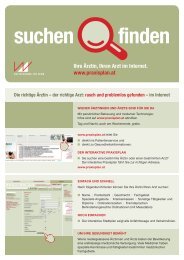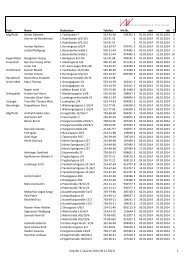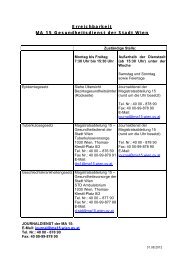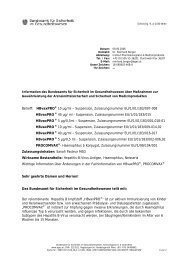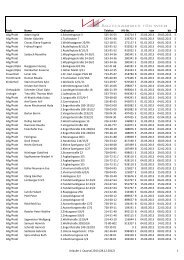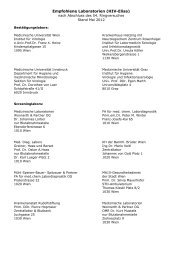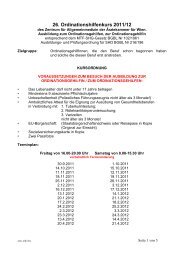Impfungen für MitarbeiterInnen des Gesundheitswesens
Impfungen für MitarbeiterInnen des Gesundheitswesens
Impfungen für MitarbeiterInnen des Gesundheitswesens
Erfolgreiche ePaper selbst erstellen
Machen Sie aus Ihren PDF Publikationen ein blätterbares Flipbook mit unserer einzigartigen Google optimierten e-Paper Software.
<strong>Impfungen</strong> für <strong>MitarbeiterInnen</strong> <strong>des</strong> <strong>Gesundheitswesens</strong>Literatur1. Nationales Impfgremium: Österreichischer Impfplan 2012. http://bmg.gv.at/home/Schwerpunkte/Praevention/Impfen/Oesterreichischer_Impfplan_2012. Zuletzt aufgerufen 2012/05/15.2. Shefer A et al.: Immunization of Health-Care Personnel. MMWR Recomm Rep2011;60(RR-7):1-45 (http://www.cdc.gov/mmwr/preview/mmwrhtml/rr6007a6001.htm)3. Keine Autoren angegeben: Impfempfehlungen für Beschäftigte imGesundheitswesen. Bull BAG 2009(43):804-808 (http://www.bag.admin.ch/themen/medizin/00682/00684/02535/index.html?lang=de)4. Keine Autoren angegeben: Empfehlungen der Ständigen Impfkommission(STIKO) am Robert-Koch-Institut. Epidemiol Bull 2011(30):275-294 (http://www.rki.de/DE/Content/Kommissionen/STIKO/Empfehlungen/Impfempfehlungen_node.html)5. Statistik Austria 2008: Gesundheitsbefragung 2006/2007.6. Bun<strong>des</strong>ministerium für Gesundheit: Jahresstatistik meldepflichtiger Infektionskrankheiten1990–1999.7. EDCC: Surveillance Report Diphtheria 2011.8. Bun<strong>des</strong>ministerium für Gesundheit: Jahresstatistik meldepflichtiger Infektionskrankheitenab 2000.9. Paulke-Korinek M, 2011: Jahresbericht impfpräventable Erkrankungen 2010.10. WHO Regional Office for Europe: 2012. WHO Epidemiological Brief No. 22,(March). http://www.euro.who.int/en/what-we-do/health-topics/diseaseprevention/vaccines-and-immunization/publications/2012/who-epidemiological-brief-22measles-and-rubella,-first-meeting-of-rvc,-afp-surveillancereporting,-polio-outbreak-preparedness.Zuletzt aufgerufen 2012/05/28.11. ECDC: 2012. European monthly measles monitoring (EMMO; Issue 8,February). http://www.ecdc.europa.eu/en/publications/Publications/Forms/ECDC_DispForm.aspx?ID=821. Zuletzt aufgerufen 2012/05/28.12. WHO Regional Office for Europe: 2012. WHO Epidemiological Brief No. 21,(February). http://www.euro.who.int/en/what-we-do/health-topics/disease-prevention/vaccines-and-immunization/publications/2011/whoepidemiological-brief-21-update-on-measles-and-rubella,-europeanregional-verification-commission-for-measles-and-rubella-eliminationrvc,-afp-surveillance.Zuletzt aufgerufen 2012/05/28.13. Redlberger-Fritz M et al.: Attributable deaths due to influenza: a comparativestudy of seasonal and pandemic influenza. Eur J Epidemiol 2012;e-pub:2012/06/08;doi:10.1007/s10654-012-9701-y14. Wilde JA et al.: Effectiveness of influenza vaccine in health care professionals:a randomized trial. JAMA 1999;281(10):908-91315. Lester RT et al.: Use of, effectiveness of, and attitu<strong>des</strong> regarding influenza vaccine among house staff. Infect Control Hosp Epidemiol 2003;24(11):839-84416. Elder AG et al.: Incidence and recall of influenza in a cohort of Glasgowhealthcare workers during the 1993-4 epidemic: results of serum testing andquestionnaire. BMJ 1996;313(7067):1241-124217. Hofmann F et al.: Influenza vaccination of healthcare workers: a literaturereview of attitu<strong>des</strong> and beliefs. Infection 2006;34(3):142-14718. GfK Group: Health Care Austria. 201019. Payne L und Coulombier D: Hepatitis A in the European Union: responding tochallenges related to new epidemiological patterns. Euro Surveill 2009;14(3)20. Gilmore A et al.: Risk of secondary meningococcal disease in health-careworkers. Lancet 2000;356(9242):1654-165521. Stuart JM et al.: Preventing secondary meningococcal disease in health careworkers: recommendations of a working group of the PHLS meningococcusforum. Commun Dis Public Health 2001;4(2):102-10522. Petsas A et al.: A secondary case of meningococcal disease in an ambulanceworker, Berkshire, November 2007. Euro Surveill 2008;13(4)23. Robert-Koch-Institut: Epidemiologisches Bulletin 2011;1. August (30)24. Dhaibo G et al.: One Dose of the Meningococcal Tetravalent ConjugateVaccine (MenACWY-TT) is Immunogenic with an Acceptable Safety Profile inUnvaccinated Subjects and those Previously Vaccinated with a MenACWYPolysaccharide Vaccine. NECTM Hamburg 2010. Poster P2-0925. Black S und Shinefield H: Issues and challenges: pneumococcal vaccinationin pediatrics. Pediatr Ann 1997;26(6):355-36026. WHO: Pneumococcal vaccines – WHO position paper – 2012. Wkly EpidemiolRec 2012;87(14):129-144 (http://www.who.int/entity/wer/2012/wer8714.pdf )27. Savulescu J: Should doctors feel able to practise according to their personalvalues and beliefs?--No. Med J Aust 2011;195(9):49728. Keine Autoren angegeben. www.vaccineethics.org. Zuletzt aufgerufen2012/07/24.29. Beauchamp TL und Childress JF: „Principles of biomedical ethics“. 6th Aufl.,2009. Oxford University Press, New York. 417 p. ISBN 978019533570530. van Delden JJ et al.: The ethics of mandatory vaccination against influenzafor health care workers. Vaccine 2008;26(44):5562-556631. Wicker S et al.: [Does patient safety justify mandatory vaccinations?]. DtschMed Wochenschr 2011;136(24):1305-131132. Wicker S et al.: Healthcare workers‘ perceptions of mandatory vaccination: resultsof an anonymous survey in a German University Hospital. Infect ControlHosp Epidemiol 2010;31(10):1066-106933. Marckmann G: [Vaccination programs between individual autonomy andcommon welfare]. Bun<strong>des</strong>gesundheitsblatt Gesundheitsforschung Gesundheitsschutz2008;51(2):175-18334. Robert Koch-Institut. Zur Situation bei ausgewählten Infektionskrankheitenin Deutschland: Keuchhusten-Erkrankungen in den neuen Bun<strong>des</strong>ländernseit 2007. Epid. Bull 2010; 47: 463-7135. Riffelmann et al. Pertussis bei Erwachsenen: Häufigkeit, Symptome undKosten. DMW 2006: 131: 2829-34 Epid. Bull. 30/201236. Halperin et al. How soon afer a prior tetanus-diphtheria-acellular pertussisvaccine? PID 2006: 25: 195-20037. Beytout et al. Safety of Tdap-IPV given one month after Td-IPV booster inhealthy young adults: a placebo-controlled trial. Hum Vaccin 2009; 5:315-21ÖVIHÖsterreichischer Verbandder ImpfstoffherstellerFinanziert durch einen „unrestricted research grant“ <strong>des</strong>Österreichischen Verban<strong>des</strong> der Impfstoffhersteller (ÖVIH)an die Medizinische Universität Wien.IMPRESSUM: Medieninhaber (Verleger) und Herausgeber: Medical Dialogue Kommunikations- und PublikationsgmbH., Lederergasse 22/16, A-1080 Wien, Tel.:01/4021754, Geschäftsführung: Karl Buresch, Redaktion dieser Ausgabe: Dr. Norbert Hasenöhrl. Für den Inhalt dieser Ausgabe verantwortlich: Univ.-Prof. Dr. UrsulaWiedermann-Schmidt, SC Priv.-Doz. Dr. Pamela Rendi-Wagner, SC Dr. Gerhard Aigner, Dr. Elmar Bechter, Vizerektorin Dr. Christiane Druml, Mag. Petra Falb, Univ.-Prof.Dr. Heidemarie Holzmann, Dr. Gabriele Karbus, Univ.-Prof. Dr. Herwig Kollaritsch, Univ.-Prof. Dr. Michael Kundi, Univ.-Prof. Dr. Elisabeth Presterl, SC Prof. Dr. Eva-ElisabethSzymanski, Dr. Barbara Tucek, Univ.-Prof. Dr. Werner Zenz, Prim. Univ.-Prof. Dr. Karl Zwiauer. Layout und DTP: Konstantin Riemerschmid, Fotos: Archiv; Titelbild: MauritiusImages; Auflage: 5.700 Stück; Nachdruck und Wiedergabe, auch auszugsweise, nur mit schriftlicher Genehmigung der Medical Dialogue GmbH.September 2012 15



